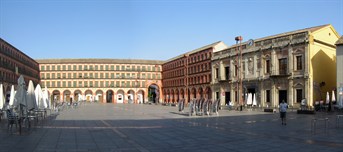The Plaza de la Corredera of Cordoba
 Another famous example of plaza mayor in the seventeenth century is the Plaza de la Corredera of Cordoba. The sole quadrangular plaza mayor in all of Andalusia, its construction was completed in 1683 under the direction of Antonio Ramos Valdés. It is currently located in the city centre and uses so-called Arco Alto (High arch) and Arco Bajo (Low arch) as ways of entry and exit. In the Middle Ages, however, the space where it was located was outside the walls, surrounding the upper part of the city. The plans to build a square in the area that had long been the scene of major commercial activities in Cordoba dated back to the sixteenth century. After the decree of King Charles (Emperor Charles V), which authorized the holding of a weekly market (1526), the square was used as the headquarters of that market. It was also used for special celebrations, as in the case of the celebrations for the victory of the Spanish fleet at Lepanto (October 7, 1571) or as the occasion of the autos de fe of December 2, 1625, of December 21, 1627 and 3 May 1655. On behalf of the corregidor Francisco Ronquillo Briceño, in 1683, the square was remodeled according to the dimensions of a 113 metre long and 55 metre wide rectangle. Despite the high cost of operations, it was not yet completed and only the façades were built of the buildings on the perimeter. Undergoing several changes over the following centuries, the Plaza de la Corredera remained until the twentieth century, the centre of the business districts and has been occasionally as a place of public executions. However, it was the celebration of bullfights (the first of which we know of was in 1513) which characterized this urban space, as evinced by its name. The Mercado de Sánchez Peña (Sánchez Peña market), used in the past as the municipal palace and as a prison and the Casas de Doña Ana Jacinta (the Houses of Doña Ana Jacinta), from the sixteenth to the seventeenth centuries face it. Both the Pósito, an old barn where the public stocks for the supply of the city were kept, and the building that had subsequently taken up that function, built in the late nineteenth century and destroyed in 1959, have been torn down.
Another famous example of plaza mayor in the seventeenth century is the Plaza de la Corredera of Cordoba. The sole quadrangular plaza mayor in all of Andalusia, its construction was completed in 1683 under the direction of Antonio Ramos Valdés. It is currently located in the city centre and uses so-called Arco Alto (High arch) and Arco Bajo (Low arch) as ways of entry and exit. In the Middle Ages, however, the space where it was located was outside the walls, surrounding the upper part of the city. The plans to build a square in the area that had long been the scene of major commercial activities in Cordoba dated back to the sixteenth century. After the decree of King Charles (Emperor Charles V), which authorized the holding of a weekly market (1526), the square was used as the headquarters of that market. It was also used for special celebrations, as in the case of the celebrations for the victory of the Spanish fleet at Lepanto (October 7, 1571) or as the occasion of the autos de fe of December 2, 1625, of December 21, 1627 and 3 May 1655. On behalf of the corregidor Francisco Ronquillo Briceño, in 1683, the square was remodeled according to the dimensions of a 113 metre long and 55 metre wide rectangle. Despite the high cost of operations, it was not yet completed and only the façades were built of the buildings on the perimeter. Undergoing several changes over the following centuries, the Plaza de la Corredera remained until the twentieth century, the centre of the business districts and has been occasionally as a place of public executions. However, it was the celebration of bullfights (the first of which we know of was in 1513) which characterized this urban space, as evinced by its name. The Mercado de Sánchez Peña (Sánchez Peña market), used in the past as the municipal palace and as a prison and the Casas de Doña Ana Jacinta (the Houses of Doña Ana Jacinta), from the sixteenth to the seventeenth centuries face it. Both the Pósito, an old barn where the public stocks for the supply of the city were kept, and the building that had subsequently taken up that function, built in the late nineteenth century and destroyed in 1959, have been torn down.
